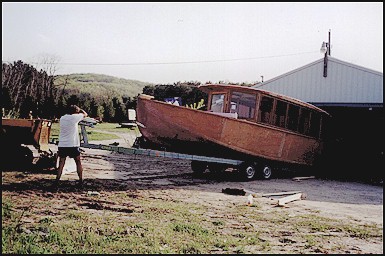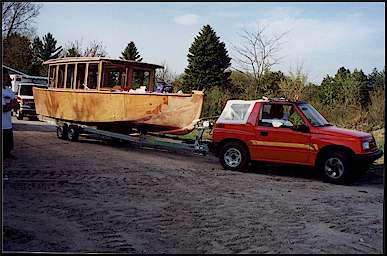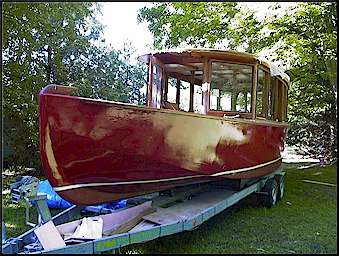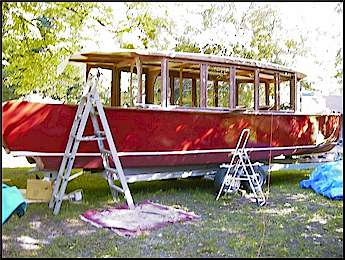| I'm back. Did not get to the boat for over a week after
my return as there is a lot to do opening up the house and setting aright all the
relatives and grand children. I just hauled the boat home on her new trailer.
One that was built in Germany. I was at a boat yard where I kept my Gemini in Fl.
and this German fellow was leaving for three years and had to unload a tandem trailer so I
got it very cheap even though it was new and fully galvanized. I extended it
and moved the wheels aft, placed center rollers foreward and bunks to rear, presto: a
trailer suited for the Topaz. I went out to the barn and while wondering what to do
with the trailer out in the drive and the boat in the barn, one of the workers happened by
with the dozer on the trailer. I told him to leave it right there after off loading.
With two floor jacks supporting the rear end and the front lifted by the blade (the
lifting via ropes, not metal), I backed it out all by myself; a little at a time. Again
using the blade, I pushed the trailer down under the front of the boat and commenced
to crank it aboard. With a little soap on the carpeted bunks and a lot of cranking
she went on like a champ. A few time in the early stages, I wondered if she might
topple, but I got past that stage soon enough. Now the topaz is sitting here at home
aboard her new trailer and ready to finish. |
 |
This picture shows me after removing the boat most of the way
out of the barn. With the help of the dozer and two floor jacks with wheels, I was
able to get this far. At this point, I had to be creative as I had no one there to
help me. I disconnected the trailer and forced the rear down with the blade.
This allowed me to begin cranking the topaz onto the trailer. |
| Speaking of which some detail can be seen. I purchase
this trailer for a little over $700 in Fl. I moved the wheels as far aft as possible
and welded on extensions. Onto these, I bolted on bunks. In the center is a
series of rollers that the cutwater and flat keel roll. At one point, the boat got a
little tipsy, but remained upright. After it was mostly on, help did arrive to get
it connected to the vehicle. |
| The second picture gives an overall view of the boat on the
trailer. It is still in the rough stages here, but can be seen better than in the
barn. Notice the little tracker which is really small beside the large load. |
 |
 |
This is really a pretty picture. The first time she went
onto a paved road. I was impressed at how easy it pulled. Right behind me all
the way to my house I was followed by friends in an ambulance. No, not because they
thought i was going to crash, they were just friends. |
| In the next pictures, the boat is completely painted on the
outside with bootstripe and some windows in. Also installed is the 75 HP honda
outboard and most of the instruments. I hope to send along updated photos within a
week. I also plan to launch her in about a weeks time. It would be easier to
finish in the water in front of my house than continue climbing in using a
ladder. I will be delayed a little as I must enlarge my dock to accomodate the
tapaz. You have to exit this boat from either end, not the middle. Thus my
dock is not going to work as it is now. |
| This shows the bow and how the cutwater and goes into the
hull. We chose the subdued red after seeing a couple of classy looking boats out in
the gulf of Mexico, this last winter of a similar color. The red was an off the
shelf color. We used synthetic acrylic enamel. The finish coat is what is
called a clear coat. Which is a polyurethane with a hardener....this needs to
be applied high volume and more pressure than used for normal paint. |
 |
| I really is a kick to put on however because of the immediate
gloss that you obtain. If you want to know if it is scratch resistant, check you
car, it has the same finish and stands up quite well. I figure it goes on so easy,
it could be re-freshed in a few years. |
 |
This is, of course, a side shot. The cutout on the rear
corners at the water line are clearly shown. With the motor in the raised position
for shallow water, the prop would chew up the sides. So I had to cut this out ahead of
time. As I see it, when emmersed, this cutout won't be seen and should have no
effect on the performance. I believe this modification will need to be made
whichever motor one uses. |
After adjusting the RPM of the engine yesterday we took her for
a ride. The inside cluttered with parts and tools. I took along a couple of
neighbors in their 70's plus my wife. The first couple of miles are on a river with
some stumps and shallows to be avoided which leads from my home to a long series of lakes
to the north. As the river twists and turns we kept the speed down and got to try
her at hull speed first. None of the instruments were connected at this point so I
can only estimate speed. However the minimum at idle with the 75 seems to be about
4-5 knots. A fast idles really gets it going at 7-9. Of note is the lack of
wake. The river was smooth after our passage. Once out on the open water, we
gradually increased speed and without going on a plane there was still a minimum of wake
but a great increase in speed. Going from displacement to a plane seemed to occur
without a transition. In other words you had to look out to determine if in fact you
were there, this without full throttle. Pushing the throttle foreword really got
exciting as the boat was going down wind and it got into a speed range I could not
estimate and I would not hold it to the highest RPM as we were
really cooking then. I backed it off to about 3/4 and felt we were skipping over the
small waves. My passengers could feel the bottom impacting all the way back. I
think the speed is going to exceed that predicted by the designer and could have been done
with a 50 hp, at least a plane. Only speculating of course.For traveling longer distances, my wife and I are more content to go at
fast hull speeds which the Topaz really does well. As to the cut out, it does as I
predicted. It really does relieve some of the turbulence which would have occurred
inside the constriction of the hull. At higher speeds, there is still considerable
splashing within this area, but restricted to aft of the motor. My friend suggested
cutting the rest of the hull below water up to the transom. My feeling is that this
curving in contributes to the lack of wake and efficiency of the hull and needs to be
there. If the minor splashing were a problem, an easy fix could be made.
Putting up a ninety degree wall on the back of the transom which blended into the curved
part of the hull on each side would work well. I will try this with some scrap foam
out of curiosity. I found that turning needed to be planned, Being a long hull
with a deep cutwater makes the boat pivot at the nose. I am used to pivoting in the
middle because of my keel. I suppose this is the nature of this type of boat and is
no problem as long as a person is aware of it. My overall impression is that this is
going to be one hell of a fun boat. The bow rides high and light and should take
waves comfortably. It track straight and does not wander even with hands off the
wheel. She is fast if you want that. At slow speeds, the comfort is great.
Best of all is the elegance of getting there. My passengers were sitting down
and enjoying the view, both from the foredeck and the settees. From a macho point of
view, it will be fun going slow and still keeping up with the fast guys now and then.
|

|